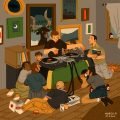
There is a familiar moment on any walk of reasonable length. Our sense of time undergoes an almost imperceptible transformation; the distance to our destination no longer concerns us, our point of departure is located in the past and we feel vividly but gracefully alive in the present. Our footsteps have a natural rhythm over which we neither need, nor feel capable of, control. The momentum of our feet silences the inner dialogue of our thoughts, as our physical and subconscious selves coalesce in therapeutic and forgiving harmony. The journey continues in a manner that now feels effortless, restorative, and reminds us of our own vitality.
Although gratifying, experience tells us such moments are far from assured during our time spent outdoors. Often the chatter in our head, the very anxieties and everyday strains of life for which we have prescribed ourselves a long walk, resurface to distract us.
For this reason, many years ago, I made certain any walk I undertook of reasonable length had recourse to being accompanied, or perhaps more accurately, salvaged, by music. The ability of music to dull and placate the thoughts, conversations and memories we are prone to dwell on when walking is incomparable, as is the manner in which a soundtrack brokers the view. The advances in technology were such that, for myself, to listen while walking became reflexive, almost habitual.
My choice of listening material was always instrumental music. I had come to the conclusion that if one is attempting to silence the voices in one’s head, it is preferable to abandon the voice altogether. Instead, my walks were conducted to meditative sounds that weaved in and out of one’s consciousness: minimalism, the composers Laurie Spiegel and Steve Reich in particular, the mid-nineties electronica of Boards of Canada, Jim O’Rourke and Aphex Twin and the long guitar ragas of 1960s primitives such as John Fahey and Robbie Basho.







